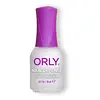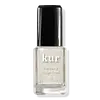What's inside
What's inside
 Key Ingredients
Key Ingredients

 Benefits
Benefits

 Concerns
Concerns

 Ingredients Side-by-side
Ingredients Side-by-side

Ethyl Acetate
PerfumingButyl Acetate
MaskingAlcohol Denat.
AntimicrobialNitrocellulose
Adipic Acid/Neopentyl Glycol/Trimellitic Anhydride Copolymer
Isopropyl Alcohol
SolventTrimethyl Pentanyl Diisobutyrate
Acetyl Tributyl Citrate
MaskingSucrose Acetate Isobutyrate
Benzophenone-1
UV AbsorberEtocrylene
UV AbsorberEpoxidized Soybean Oil
EmollientPolyvinyl Butyral
Hydrolyzed Wheat Protein
Skin ConditioningTocopheryl Acetate
AntioxidantCarthamus Tinctorius Seed Oil
MaskingMelilotus Officinalis Extract
AstringentChamomilla Recutita Flower Extract
MaskingEquisetum Hyemale Leaf/Stem Extract
Skin ConditioningWater
Skin ConditioningDimethicone
EmollientCalcium Pantothenate
CI 60725
Cosmetic ColorantEthyl Acetate, Butyl Acetate, Alcohol Denat., Nitrocellulose, Adipic Acid/Neopentyl Glycol/Trimellitic Anhydride Copolymer, Isopropyl Alcohol, Trimethyl Pentanyl Diisobutyrate, Acetyl Tributyl Citrate, Sucrose Acetate Isobutyrate, Benzophenone-1, Etocrylene, Epoxidized Soybean Oil, Polyvinyl Butyral, Hydrolyzed Wheat Protein, Tocopheryl Acetate, Carthamus Tinctorius Seed Oil, Melilotus Officinalis Extract, Chamomilla Recutita Flower Extract, Equisetum Hyemale Leaf/Stem Extract, Water, Dimethicone, Calcium Pantothenate, CI 60725
Ethyl Acetate
PerfumingButyl Acetate
MaskingIsopropyl Alcohol
SolventAcetylated Hydrogenated Castor Glyceride
Adipic Acid/Neopentyl Glycol/Trimellitic Anhydride Copolymer
Nitrocellulose
Cellulose
AbsorbentTalc
AbrasiveStyrene/Acrylates Copolymer
Hydrated Silica
AbrasiveTrimethyl Pentanyl Diisobutyrate
Allium Sativum Bulb Extract
Skin ConditioningOenothera Biennis Flower Extract
AstringentStearalkonium Bentonite
Gel FormingStearalkonium Hectorite
Gel FormingMercaptopropyltrimethoxysilane
Methacryloyl Propyltrimethoxysilane
Methyltriethoxylane
SmoothingGlycidoxypropyl Trimethoxysilane
Hydrolyzed Wheat Protein
Skin ConditioningBiotin
AntiseborrhoeicTocopherol
AntioxidantParaffin
PerfumingBenzophenone-1
UV AbsorberHydrogenated Microcrystalline Wax
Emulsion StabilisingWater
Skin ConditioningCarthamus Tinctorius Seed Oil
MaskingDimethicone
EmollientCitric Acid
BufferingChamomilla Recutita Flower Extract
MaskingCucumis Sativus Fruit Extract
EmollientTocopheryl Acetate
AntioxidantBrassica Campestris Seed Oil
Skin ConditioningCalcium Pantothenate
Retinyl Palmitate
Skin ConditioningEthyl Acetate, Butyl Acetate, Isopropyl Alcohol, Acetylated Hydrogenated Castor Glyceride, Adipic Acid/Neopentyl Glycol/Trimellitic Anhydride Copolymer, Nitrocellulose, Cellulose, Talc, Styrene/Acrylates Copolymer, Hydrated Silica, Trimethyl Pentanyl Diisobutyrate, Allium Sativum Bulb Extract, Oenothera Biennis Flower Extract, Stearalkonium Bentonite, Stearalkonium Hectorite, Mercaptopropyltrimethoxysilane, Methacryloyl Propyltrimethoxysilane, Methyltriethoxylane, Glycidoxypropyl Trimethoxysilane, Hydrolyzed Wheat Protein, Biotin, Tocopherol, Paraffin, Benzophenone-1, Hydrogenated Microcrystalline Wax, Water, Carthamus Tinctorius Seed Oil, Dimethicone, Citric Acid, Chamomilla Recutita Flower Extract, Cucumis Sativus Fruit Extract, Tocopheryl Acetate, Brassica Campestris Seed Oil, Calcium Pantothenate, Retinyl Palmitate
Ingredients Explained
These ingredients are found in both products.
Ingredients higher up in an ingredient list are typically present in a larger amount.
We don't have a description for Adipic Acid/Neopentyl Glycol/Trimellitic Anhydride Copolymer yet.
Benzophenone-1 absorbs UV.
We don't have a description for Butyl Acetate yet.
Calcium Pantothenate is calcium salt from Vitamin B5. It can be naturally found in plants and animals.
Calcium Pantothenate is a potent antioxidant. Antioxidants help fight free-radical molecules. Free-radical molecules are capable of damaging our cells and other genetic material. Antioxidants help stabilize free-radicals by donating extra electrons. This may help reduce the signs of aging.
Our bodies use Calcium Pantothenate for various metabolic functinos. These functions include metabolizing carbohydrates, proteins, and fatty acids.
Learn more about Calcium PantothenateCarthamus tinctorius seed oil comes from safflower, one of humanity's oldest crops.
Safflower seed oil contains a high percentage of linoleic acid and oleic acid. It also contains Vitamin E. These three components are effective moisturizers.
Vitamin E helps nourish your skin's lipid barrier. It is also a potent antioxidant. Antioxidants help fight free-radical molecules, or unstable molecules that may damage your skin cells.
Due to its high fatty acid content, this ingredient may not be malassezia folliculitis safe.
Thoughout history, safflower has been used for dying fabrics and in food as a saffron substitute.
Learn more about Carthamus Tinctorius Seed OilChamomilla Recutita Flower Extract comes from the Chamomile flower.
Chamomile is rich in antioxidants and has anti-inflammatory properties. Several compounds found in chamomile help with soothing, such as bisbolol.
Antioxidant components in chamomile make it an effective ingredient to help slow the signs of aging. Antioxidants help fight free-radical molecules, or molecules that may damage your skin.
Essential oils from chamomile have been found to improve wound healing due to its antimicrobial properties.
Ancient Greeks and Egyptians used Chamomile to treat skin redness and dryness. Chamomile has also been used to help treat stomach issues.
Learn more about Chamomilla Recutita Flower ExtractDimethicone is a type of synthetic silicone created from natural materials such as quartz.
What it does:
Dimethicone comes in different viscosities:
Depending on the viscosity, dimethicone has different properties.
Ingredients lists don't always show which type is used, so we recommend reaching out to the brand if you have questions about the viscosity.
This ingredient is unlikely to cause irritation because it does not get absorbed into skin. However, people with silicone allergies should be careful about using this ingredient.
Note: Dimethicone may contribute to pilling. This is because it is not oil or water soluble, so pilling may occur when layered with products. When mixed with heavy oils in a formula, the outcome is also quite greasy.
Learn more about DimethiconeEthyl Acetate is a fragrance.
We don't have a description for Hydrolyzed Wheat Protein yet.
Isopropyl Alcohol is more commonly known as rubbing alcohol. It is most commonly used as a solvent, meaning it helps other ingredients dissolve.
This ingredient is an astringent alcohol. Astringent alcohols may also irritate skin as they high amounts may strip away your skin's natural oils.
Other types of astringent alcohols include:
According to the National Rosacea Society based in the US, you should be mindful of products with these alcohols in the top half of ingredients.
Any type of sanitizing product will have high amounts of alcohol to help kill bacteria and viruses.
Learn more about Isopropyl AlcoholWe don't have a description for Nitrocellulose yet.
Tocopheryl Acetate is AKA Vitamin E. It is an antioxidant and protects your skin from free radicals. Free radicals damage the skin by breaking down collagen.
One study found using Tocopheryl Acetate with Vitamin C decreased the number of sunburned cells.
Tocopheryl Acetate is commonly found in both skincare and dietary supplements.
Learn more about Tocopheryl AcetateWe don't have a description for Trimethyl Pentanyl Diisobutyrate yet.
Water. It's the most common cosmetic ingredient of all. You'll usually see it at the top of ingredient lists, meaning that it makes up the largest part of the product.
So why is it so popular? Water most often acts as a solvent - this means that it helps dissolve other ingredients into the formulation.
You'll also recognize water as that liquid we all need to stay alive. If you see this, drink a glass of water. Stay hydrated!
Learn more about Water